
For a product that has been around for over 5,000 years, there are still a lot of unknowns for the masses. We are here to demystify these classic comforts and give you a little history of how they came about. We will try to answer your burning candle questions and hopefully give you some background on their origins.
How long have candles been around?
Candles have been used for more than 5,000 years as a source of light for the home, travelers at night, celebrations, or religious ceremonies.
Who invented candles?
While the Ancient Egyptians were attributed to having used candles first in 3,000 B.C., the Romans were credited with developing the wicked candle before that time.
How are candles made?
Historians have found evidence that many other early civilizations developed wicked candles. Candle wax has been created from different cultures out of a variety of ingredients. Early Chinese candles are said to have used rice paper wicks and wax from a combination of indigenous insects and seeds. In Japan, candles were made from tree nuts, while in India, candle wax was made by boiling the fruit of the cinnamon tree.
Most early Western cultures used animal fat or tallow to create candle wax until beeswax was later introduced in the Middle Ages. Colonial women in America discovered that boiling the grayish-green berries of bayberry bushes produced a sweet-smelling wax that burned cleanly; however, this was a tedious task. In the 18th century, the whaling industry brought in a new form of wax created from spermaceti — obtained by crystallizing sperm whale oil.
Today, 95% of candles use Paraffin wax, which was introduced in the 1850s. This came after chemists learned how to efficiently and economically refine petroleum byproducts to create candle wax. This key ingredient became so prevalent due to its ability to burn cleanly and consistently. It was also much cheaper than any other candle fuel. Although the advent of the lightbulb created a decrease in demand for candles, they soon enjoyed a renewed popularity when the growth of U.S. oil and meatpacking industries came about in the first half of the 20th century. This increase is due to the excess in the byproducts that had become available to create the basic ingredients of candles – paraffin and stearic acid.
In the 1990s there was an unprecedented global surge in candle popularity and new forms of waxes were being tested and developed from soybean wax to palm wax.
Are candles bad for you?
This depends on the type of candle. Not all candles are bad for you but some emit toxins and carcinogens. When looking at the toxicity of the candle, you must consider the wax, wick, and fragrance type. Most candles on the market today are made from paraffin wax with potentially toxic metal wicks and synthetic fragrances. Stabilizers are often added to the paraffin to control the way the candle burns.
Paraffin wax is made from petroleum byproducts and comes as a black sludge that is leftover after oil and gas production. This wax is treated, bleached (with a 10x concentration of our normal household bleach), and is processed into a solid that is used to make a variety of things including candles.
According to the EPA, paraffin wax candles are a leading cause of indoor air pollution.
Here are a list of a few common chemicals often present in paraffin wax:
- Trichloroethane
- Chlorobenzene
- Ethylbenzene
- Styrene
- Xylene
- Phenol
- Cresol
- Cyclopentene
- Acetone
- Trichlorofluoromethane
- Carbon Disulfide
- 2-Butanone
- Carbon Tetrachloride
- Tetrachloroethene
This is not representative of all of the candles on the market. There are a small minority of brands that create cleaner candles, including Malibu Apothecary.
What candles are safe or nontoxic?
When purchasing a clean candle, it is important to consider the following: wax, wick, and fragrance.
Candles, when made with these ingredients below, are often safe for you and your pets.
- Wax: Coconut, Apricot, Soy, Beeswax
- Wick: Cotton, Paper
- Fragrance: Essential Oils or Synthetic Fragrances that are free of parabens, phthalates, and sulfates.
What are used to make Malibu Apothecary candles?
Malibu Apothecary thoughtfully sources all of our ingredients to bring clean and safe candles to your home.
- Wax: Coconut and Soy Blend Wax
- Wick: 100% Cotton Braided Wick
- Fragrance: Essential Oil-infused Fragrances and Fine, Nontoxic Synthetic Fragrance Oils that are Cruelty-free, Phthalate-free, Paraben-free, Sulfate-free, and never use gasoline byproducts.
Are Candles bad for dogs, cats, or other animals?
Just as with humans, this depends on the ingredient used in the candle. These aforementioned toxic candles can release volatile organic compounds as well as toxins like lead, naphthalene, formaldehyde, and phthalates. Paraffin wax and toxic fragrances oils can produce carcinogenic soot and can exacerbate respiratory conditions such as asthma in both humans and pets.
Phthalates, another airborne product released from burning candles, have been implicated in causing endocrine system disruption leading to diabetes, birth defects, and cancer.
Candles that use only clean ingredients, like the ones listed above, should be safe to burn. Malibu Apothecary candles are always safe to burn and will not produce toxic, airborne carcinogens. It is always important though to monitor your candles while burning and keep the flame away from pets or children.
Why do some candles smell stronger than others?
The strength of the candle fragrance is known as your "scent throw" with a "hot throw" or "cold throw". Cold Throw is the strength of the candle measured by your ability to smell it before it is burned. Often candles can have a strong smell when they are first purchased and then when you burn them, this scent can hardly be smelled. This is because it has a poor "hot throw". A Hot Throw is the strength of the candle when it is burning. If you can smell your candle strongly after lighting it, it has a better hot throw.
The strength of the candle will depend on the proportion of fragrance oil to wax that is used. Most candle brands use anywhere from 4-7% fragrance oil to wax. At Malibu Apothecary, we use a 12% concentration of fragrance oil. This makes our candles incredibly fragrant and will fill your room with scent.
Typically, other candle companies do not use a higher concentration of perfume oil either due to cost or the type of wax they use. Some waxes will not be able to hold fragrances over 8-10% concentration and will often "frost" or "sweat". Our proprietary wax made with clean-burning coconut and soy, allows us to increase the concentration of our fragrance without compromising the integrity of the wax.
Can candles be recycled?
Yes! You can always find ways to recycle your candle boxes or containers. Malibu Apothecary crafts clean candles in beautiful vessels that are made for reuse in mind. Our customers often recycle their candle jars to reuse for succulent planters, beauty or makeup brush holders, jewelry containers, etc. You can follow us @malibuapothecary for new ideas on ways to repurpose your candle jars!
Why do some candles burn black smoke?
This can be caused by the wax or wick. The primary cause of black smoke occurring when burning candles is an overly long wick. When a candle burns, the liquid wax that has melted will be pulled up through the wick to feed the flame. If your wick is too long, this delicate balance of heat and fuel will cause a chemical reaction that produces excess soot and smoke.
An easy solution to keep your candles from burning black smoke is to trim your wick. Wicks should be between 1/8 inch and 1/4 inch before you light the candle. The easiest way to trim your wick is with a wick trimmer although scissors can also do the job.
What is in fragrance oil?
Fragrance oil for candles can be made up of the following components: essential oils, aroma chemicals, solvents, and diluents.
"Essential oils are pure liquids containing aroma compounds that are removed from the seeds, flowers, leaves, roots, and stems or bark of plants through methods such as distillation, expression or extraction."
Because essential oils are not available for every scent, synthetic aroma chemicals that come in the form of powder or liquid can be used to mimic the essence of things such as "Birthday Cake". Synthetic fragrances or fragrance oils are man-made but this does not mean it is unsafe or toxic. In fact, there are many natural ingredients that can be harmful when burned, and many synthetic ingredients have been created or tested to burn more safely and effectively.
Our fragrance oil is a combination of all-natural essential oils and man-made fragrance oils that have been tested and formulated for clean-burning candles.
Typically, fragrance manufacturers do not disclose their ingredients due to "proprietary formula" rules as scents can be considered intellectual property. That is why it is so important to verify if your candles or fragrance based products are safe.
Solvents are dissolving agents while diluents are diluting substances. When a synthetic aroma chemical is in powder form, a solvent is required to convert it to a liquid for use in the fragrance oil. Solvents can help the components of a fragrance burn more easily, blend better, improve the throw, and increase longevity.
If you have essential oils in a highly concentrated form, a diluent is required to thin it so that it will remain suspended in the liquid fragrance oil. This substance adjusts the density of fragrance oils so that it's easier for the wax or fragrance mixture to be effectively pulled up through the wick for the flame to burn.
Sources:
https://candles.org/history/#:~:text=Early%20Origins,reeds%20in%20melted%20animal%20fat.
https://www.candlescience.com/learning/whats-in-fragrance-oil
Read more

Barcelona Blueberry Craft Cocktail | Mixed with Gosling's Ginger Beer, Fresh Lime Juice, Belvedere Vodka, Frozen Blueberries ... Gosling Ginger Beer (1/2 Can) Fresh Lime Juice (2 TSPS) Belvede...

Where traditional charm meets modern luxury mix, our San Jose Del Cabo cocktail is much like its muse. Our coastal inspired cocktail packs a punch sure to please just like this fun, artsy old town ...

Leave a comment
All comments are moderated before being published.
This site is protected by hCaptcha and the hCaptcha Privacy Policy and Terms of Service apply.